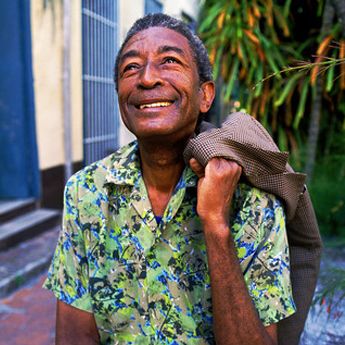
Folk chanter.
Havana, Cuba, May 11, 1925 - February 8, 2005. Considered the most famous among the Cuban akpwones. Ocha Niwe, his ritual name, became a chanter and folk dancer without abandoning the Rule of Ocha, a religious cult to which he was consecrated and where he learned and develop his capacity and talent as chanter.
Lázaro Ros was born at the popular Santos Suárez neighborhood and, in spite of his family disagreement, since very young he became interested in the musical and ritual atmosphere of the houses of Ocha. Otilia Mantecón Hernández, a santera from Matanzas, guided him through chanting and the essential knowledge of this cult. When he was 13 years old, he already chanted in the Santo parties. At 17, he was allowed to chant in one of the most respectful santería houses in Matanzas, the house of Fermina Gómez, and he was so accepted that he remained there to learn the most peculiar and diverse ways and intonations of the language and chanting among the luc
umí, arará, eguado, iyesá and other descendants. Later on, he toured the island as chanter and he finally mastered the different styles of ritual chanting.
In 1949 he began his professional career by singing at the Sunday program of folkloric music broadcast through RHC Cadena Azul radio station. He combined this activity with very different trades and with santo parties. In 1959 he was called by Argeliers Leon to join, as both chanter and dancer, the group who performed the first folkloric shows at the Covarrubias Hall in the National Theater of Cuba. Later on, he cooperated with the Institute of Ethnology and Folklore in the Cuban Academy of Sciences. Researchers like Isaac Barreal, Rogelio Martínez Furé, Alberto Pedro, Miguel Barnet and Argeliers himself, invited him as chanter to illustrate and support their lectures. He also cooperated with the Movement of Amateur Artists, imparting folkloric chanting classes and making some recordings.
In 1962 he joined the founding group of the Conjunto Folclórico Nacional (CFN). Since then, he has developed a successful artistic career which included many tours across Europe, Latin America, the United States and he has recorded Cuban folkloric music for radio and television in Belgium, Algeria and Spain; for the recording collection Chant du Monde in Paris and for the BBC in London.
In 1971 he created his first dancing drama entitled "Alafín de Oyó", whose premiere constituted a great success for the CFN as was the "Arará" drama made in 1979. In 1980 he created the Choir of Yoruba Chants and since 1988 he became member of the Faculty of the International Folkloric Laboratory (FOLKCUBA, sponsored by the CFN).
Due to his powerful and beautiful voice, with a broad register that allowed him to chant from the lowest to the highest tones, he performed together with important personalities such as María Remolá, the soprano, with whom he interpreted the music for the ballet entitled "El río y el bosque" from the repertoire of the Cuban National Ballet, or with representatives of the most contemporary music such as "Síntesis" and "Mezcla" groups.
During the 1960s, he made his debut in the filming industry, in the film entitled "Suite Cubana" by choreographer Ramiro Guerra. He also participated in "Osaín" film as well as in other documentary films dealing with African roots and Cuban santería.
In 1990, he became the protagonist of the documentary film entitled "Ogún" from the Cuban Institute of Art and Filming Industry.
He worked as professor in institutes such as the First Movement of Cuban Amateur Artists, the Conjunto Folklórico Nacional, Havana University, the National institute of Art and the National School of Art. Likewise, he also cooperated as professor for the School of Humanities, in Mexico City and the House of Culture, in Tijuana, Mexico.
He received many awards including: Tonel de Oro Collar de Plata, in Paris, the First Award at two Peruvian Festivals; the Grand Prix at the Bilica Festival, in France; the First Award at the Festival of Venice, Italy; the Templo de Oro Grand Prix in Sicily, Italy; the 1989 EGREM Award for the LD entitled "Ancestros" by the "Síntesis" group and the 2001 Cubadisco Award in the category of Folkloric Music with the CDs entitled "Yemayá" and "Oshún" from the "Orisha Ayé" collection. In 2002 he was nominated for the Latin Grammy with the CD "Yemayá" in the category of Folkloric Music.
He received many acknowledgements namely, The key to Boston City, the Diploma of L.A, University (twice) and the Emeritus Artist UNEAC title.
Lázaro Ros obtained the National Culture Award and the Alejo Carpentier Medal, high awards granted to him in Cuba.